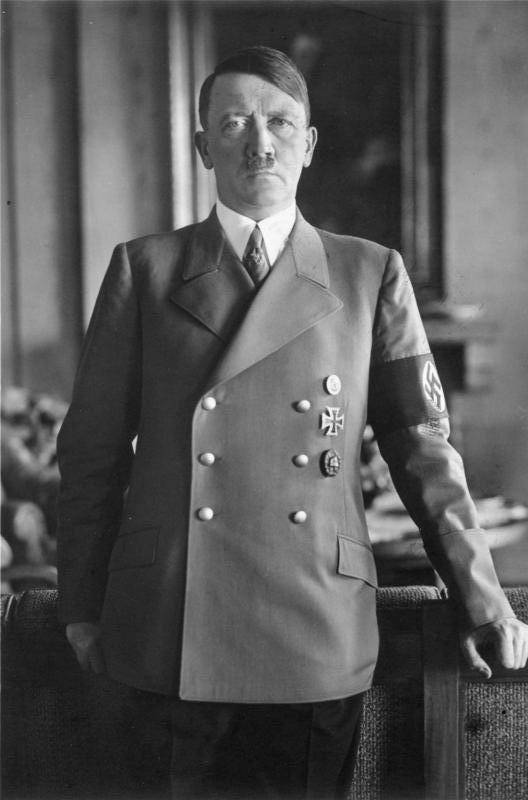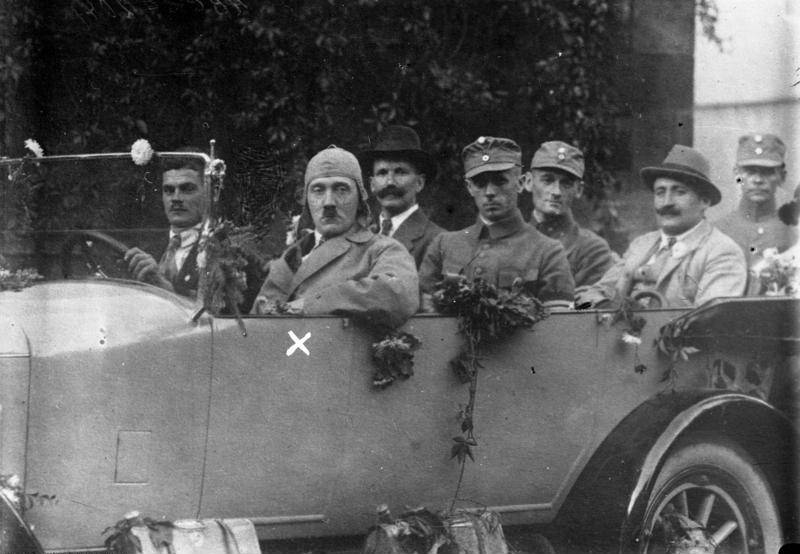Who nurtured Nazism in Germany

In the ruins of an empire
The despondency and defeatism that reigned in the rear struck Hitler (Made in Europe - Adolf Hitler), who was on leave after being injured. It was then that he thought about a career in politics. Hitler considered the defeat in the war of the Second Reich and the November Revolution of 1918 to be the work of the “fifth column”, which stabbed the German army and the Kaiser in the back.
Hitler, after another wound and hospital in December 1918 - January 1919, was sent to serve as an escort in a prisoner of war camp in Traunstein. But soon the prisoners were released, and the corporal was out of work. The army was disbanded, many soldiers and officers survived as best they could on the ruins of the empire. Millions of unemployed in overcoats in the conditions of the collapse of the former life and economy. Some flowed into the revolutionary and counter-revolutionary, right-wing detachments. Others became gangsters or committed suicide without surviving the social catastrophe.
Hitler returned to Munich, to the empty barracks of his 2nd Bavarian regiment. His loyalty was appreciated, they were allowed to live. At this time, Adolf was still fond of art. But he was fascinated by politics. Captain Karl Mayr, head of the intelligence department of the 4th Reichswehr group of troops, took part in the fate of Hitler. Mayr introduced Hitler to Ernst Röhm, a member of a secret right-wing officer's union.
Confusion reigned in the army at that time, new armed forces were being created - the Reichswehr. The officers were looking for an opportunity to evade the conditions of the obscene Treaty of Versailles. Save a full-fledged army. Röhm served in the headquarters of the Bavarian commander von Epp and proposed the creation of courses for educator officers and propagandists. Hitler was sent to these courses. The teachers, as was customary in the Second Reich, held pan-German, nationalist and anti-Semitic views.
Adolf showed himself as a talented orator. He was seconded to the political department of the Bavarian Reichswehr. He had no position or salary. The functions of the political department itself were uncertain.
"The Thule Society"
Political life in Germany was seething. Like mushrooms after a warm rain, new parties arose. True, for the most part, no one knew outside their area and the pub. There were monarchists, nationalists, pagan pan-Germanists, separatists, democrats and various leftists.
The political department tried to follow the new parties in Munich. On September 12, 1919, Hitler's boss, Captain Mayr, sent him to a pub where a meeting of the German Workers' Party was taking place.
The party was founded in early 1919. It was based on the mystical, secret organizations "German Order" and "Thule Society". They stood for the purity of the nation. They say, it is necessary to cleanse ourselves of the representatives of the "lower times", fall to the roots and thereby obtain the magical keys to victory. The official tasks of "Thule" proclaimed the study of ancient Germanic stories and culture. In the future, the ideology of "Thule" became the basis for the ideology of the Third Reich.
The Thule branch in Munich was headed by Rudolf von Sebottendorff (real name Adam Glauer). He was a notorious adventurer and swindler. Lived in Egypt and Turkey. How a Turkish citizen joined the Sufi tradition, local mysticism. He was also a member of Freemasonry, earned money by astrology, lectures on the occult and the organization of relevant clubs. In 1913 he returned to Germany and presented himself as a baron, although he was from a working-class family. Established ties with the German Order.
He turned out to be a good organizer, recruited hundreds of people. Acquired the Munich weekly München Observer (Munchener Beobachter), which was later renamed the People's Observer (Völkischer Beobachter). The editor of the newspaper was the journalist Karl Harrer. He became the first chairman of the German Workers' Party. Anton Drexler became chairman of the Munich group.
Sebottendorff-Glauer himself, due to allegations of negligence, as a result of which the names of several prominent members of the society became known to the government of the Bavarian Soviet Republic, and they were executed, and due to the loss of money, he left the place of the leader of the local Thule department. He went to Austria, then Switzerland and returned to Turkey, where he published several works and worked for German intelligence.
Creation of the NSDAP
Hitler should have simply analyzed the new batch. Without the energetic Sebottendorff, the organization degenerated. A few dozen people remained in it. One of the activists spoke about the secession of Bavaria. Hitler was hurt by this, and he made a hot rebuke. Drexler liked his speech. He sent him a postcard that the corporal had been accepted into the party (without a statement from Adolf).
Hitler agreed. He already realized that he had no prospects in the political department of the Reichswehr. Rem supported him. Hitler immediately took over the leadership of propaganda and soon began to determine the activities of the entire party. Hitler's personality attracted people. In October 1919, 100 people listened to him in the Hofbräukeller beer hall, then 200, in February 1920 he already collected 2 for rallies. He began to receive fees for speeches. Soon Hitler pushed Harrer and Drexler from the first positions.
Hitler's trump card was the connection with the army. Rem obtained 60 marks from the funds of the Ministry of War. With this money, the newspaper "People's Observer" was bought out and reorganized, it became a party organ. Röhm's colleagues began to embody the ideas of the "hidden army" - assault squads (German Sturmabteilung, abbreviated SA) are created under the party. Outfit and some weapon came from army warehouses. Form and organization, some prospects - attracted attention, distinguished the party from others.
The party became known as the National Socialist German Workers' Party, NSDAP (German: Nationalsozialistische Deutsche Arbeiterpartei - NSDAP). Her program, "Twenty-Five Points", was compiled by Drexler, Hitler and Feder.
At the heart of the program were demands: the unification of all Germans into a Greater Germany; repeal of the provisions of the Versailles and Saint-Germain peace treaties; living space for the Germans. Anti-Semitism and xenophobia were promoted. The party opposed "percentage slavery", for a decent pension and the priority of productive activity. For the struggle "against those who, by their activities, harm the interests of society." For a strong centralized government, a people's army, the broad development of public education and the improvement of the nation (protection of motherhood and childhood, the development of mass physical culture).
As a result, the program bore a revolutionary, national-socialist character. She proclaimed the struggle for the welfare of the common people, called for the oppression of the rich, usurers and speculators. The flag was red, but adorned with a swastika in a white circle. Sacred and ancient sign of fire.
The party was small - only 3 thousand people. There were dozens, if not hundreds, of such parties in Germany. They were born and disappeared, not everyone had time to compose a program. But Hitler was already taken into development, they noticed.
What attracted overseas observers? Energy? Pressure? Connection with the occult, ancient teachings? Or connection with the army? But Hitler's anti-democratic ideas did not frighten Washington.
Since that time, the Hitler project began to be supported and financed. The former Chancellor of Germany, Brüning, in his memoirs, which he allowed to be published only after his death, noted:

Hitler on a propaganda tour, 1923
To be continued ...
- Alexander Samsonov
- https://ru.wikipedia.org/
Information